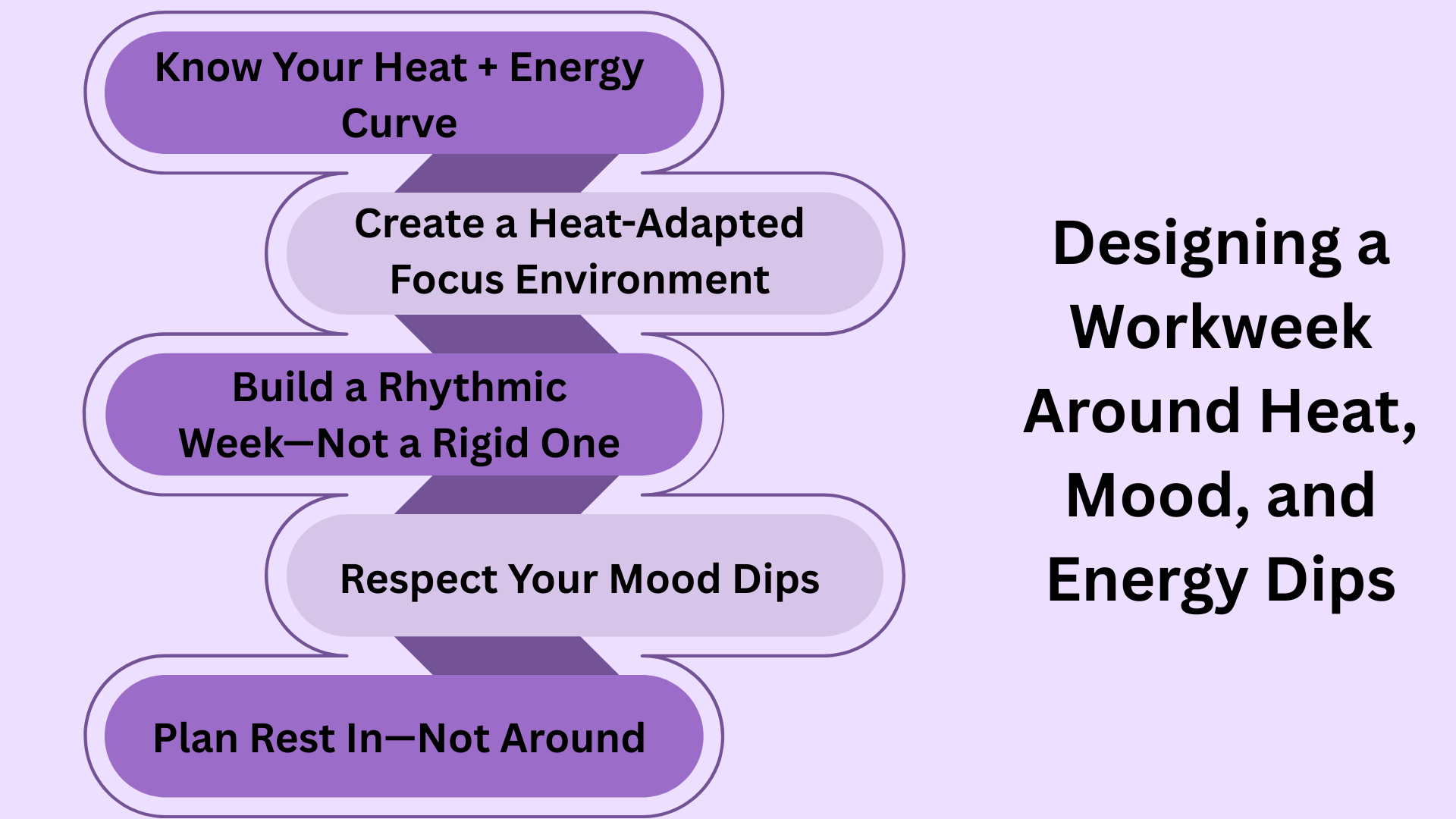Not every week is created equal—and neither is every day.
There are mornings when your brain hums with clarity and motivation… and afternoons when it feels like you’re trudging through molasses. There are weeks where the heat zaps your momentum before lunch. And let’s not even talk about those Wednesday energy crashes that leave you Googling “quick productivity hacks” like it’s your job.
Especially in the summer, your focus isn’t just about your calendar—it’s about your conditions. The weather, your mood, your natural energy cycles, and even the vibe of your environment can shift how you work.
So instead of pushing through like every day is the same, what if you designed your workweek around your real rhythms?
Here’s how to build a week that honors your energy dips, supports your mood, and adjusts for the reality of working through the heat.

Step 1: Know Your Heat + Energy Curve
When it’s hot, everything feels heavier. Mentally, physically, emotionally. And depending on your chronotype, your energy might already peak and drop in predictable patterns.
Here’s what to consider:
- Heat-fatigue is real: When outdoor temps rise, so does your body’s need to slow down. Research shows that high temperatures can reduce cognitive performance and increase irritability—so plan accordingly.
- **Know your natural peaks**: Are you sharpest at 9AM or after lunch? Use that info to block high-focus tasks during your personal “golden hours.”
- Afternoons might need to be lighter: Don’t stack your most demanding tasks during the hottest, most sluggish part of the day (usually 1–4PM).
✅ Try this: Keep a heat-aware weekly planner. Each Sunday, look at the forecast and map out high-focus work during cooler mornings. Reserve admin tasks, meetings, or creative recovery for warmer afternoons.
Step 2: Create a Heat-Adapted Focus Environment
If you’re trying to work in a hot, muggy space with zero airflow, your brain’s not going to cooperate. Temperature can affect memory, problem-solving, and decision-making.
Here’s how to keep your workspace working for you:
- Use fans or cool mists to maintain airflow and regulate temperature.
- Switch locations midday if your space gets too hot—libraries, cafés, or shaded patios can offer surprising clarity.
- Hydration = cognition: Don’t underestimate the power of cold water and electrolytes for mental sharpness.
- Layer in cooling soundscapes: LifeAt’s ambient options like “Rainy Day Café” or “Forest Stream” can trick your nervous system into a calmer, cooler state.
✅ Pro tip: Save a “cool down” focus session in LifeAt to use when your mood or energy starts to dip. The right audio and visual cues can reset your brain, fast.
Step 3: Build a Rhythmic Week—Not a Rigid One
Traditional time blocking doesn’t account for heatwaves, brain fog, or low social batteries. Instead, try rhythmic planning: A more intuitive way to balance deep work and recovery throughout the week.
Here’s a sample weekly rhythm:
- Monday: Mental clarity is highest—use it for planning, writing, creative strategy.
- Tuesday–Wednesday: Midweek stretch—stack 1–2 deep work blocks with Pomodoro-style breaks and early wrap-ups.
- Thursday: Start slowing the tempo. Prioritize light edits, admin, or collaborative tasks.
- Friday: Soft structure. Keep your calendar light and add in a recovery ritual (like a 25-min LifeAt focus session + digital tidy-up).
✅ Pomodoro Sound Routine: Pair 45 minutes of deep work with cooling, lo-fi ambient music and 15 minutes of total rest—feet up, water nearby, and nothing to prove.
Step 4: Respect Your Mood Dips
Mood isn’t always predictable, but it often follows a pattern—especially when heat and stress are involved.
A few gentle tactics to help:
- Start the day with one “feel-good” task—something small but meaningful.
- Use sound as a state shift: Choose uplifting focus playlists or binaural beats that match your current mood and help shift you into a better one.
- Lower the stakes during off days: If your mood is low, aim for progress over perfection. Even 45 minutes of focus counts.
✅ Reframe it: Instead of “I didn’t get enough done,” try “I listened to my energy, focused when I could, and protected my bandwidth.”
Step 5: Plan Rest In—Not Around
Heat and mood dips are natural. So is needing more rest than usual in July or August.
Instead of crashing mid-week, plan mini resets into your day:
- Midday microbreaks: Even 5 minutes of eyes-closed stillness or stepping outside can help.
- Post-work rituals: Use sound to gently close the work tab—think ambient jazz, wind-down rain, or beachy white noise while prepping dinner.
- No-go zones: Set boundaries with Focus Mode on iPhone or use LifeAt’s timer feature to stay present and avoid digital fatigue.
✅ Remember: Focus doesn’t mean force. Rested brains recover faster and return sharper.

Final Thoughts: Listen to Your Energy First
Designing a good workweek isn’t about squeezing more in. It’s about making sure the right energy meets the right tasks—at the right time.
So this summer, give yourself permission to adapt. Let your schedule ebb and flow. Let your focus rituals cool you down. Let your tools (like LifeAt) help you find your rhythm again.
You don’t need to hustle through the heat. You just need to work with it.

.png)

.avif)